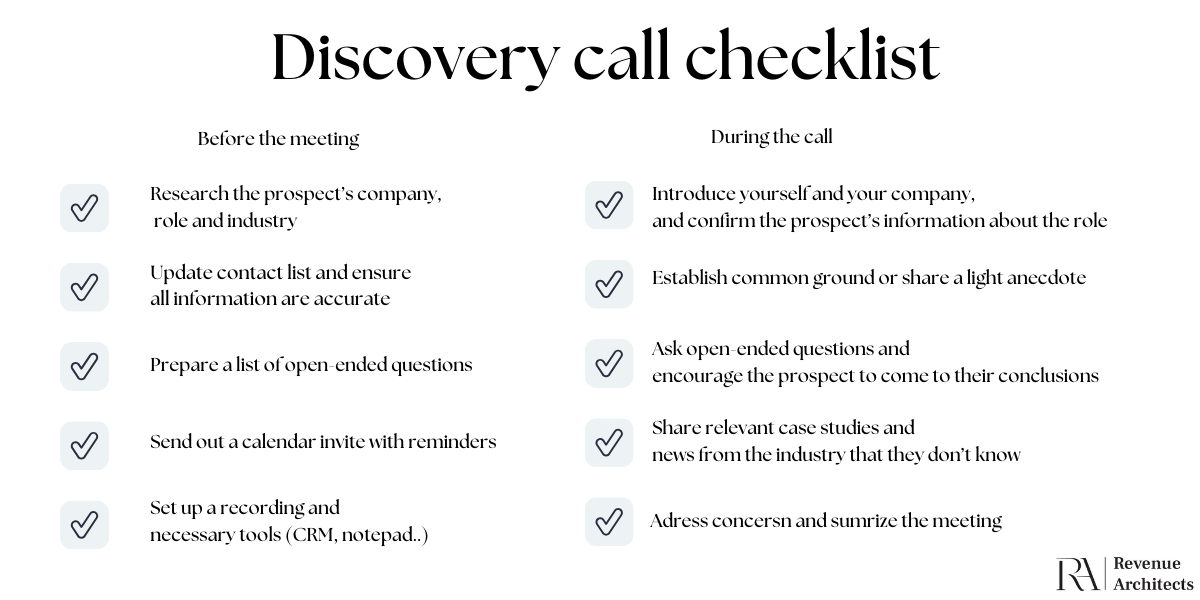Discovery calls are a favourite topic at Revenue Architects because they are pivotal for a company’s functioning and revenue. That’s why we’re sharing the basics of this crucial first step in sales. We’ll provide a simple script and six steps to making a successful discovery call, emphasising preparation, confidence, effective questioning, active listening, follow-up, and improvement.

We’ll also address the length of a discovery call, highlighting the importance of balancing engagement and information gathering. Research shows dissatisfaction in many sales calls, so a well-established strategy involving pre-call research, impactful questioning, and effective follow-up is essential.
Ultimately, effective discovery calls lead to stronger connections and increased revenue. Stay tuned for further insights from our experts on mastering the art of sales. It’s an ongoing journey of improvement, adaptation, and leveraging technology to maximise effectiveness while embodying resilience and persistence for enduring success.
What is a Discovery Call?
A discovery call is a conversation with a prospect early in the sales process to determine if they’re right for the product and find motivations to make the sale. It occurs after the prospect has shown interest in your company and converted from a cold lead to a warm opportunity.
Discovery calls give sales reps insights into the prospect’s pains and goals. They help them pitch the right products effectively and build trust and rapport, which are crucial for closing the deal.
So, how do you do that?
You can prepare and write a script that you will adjust over time.
The opening sets the tone. Start by confirming the time frame and setting expectations. Ensure the call is a conversation, not just a sales pitch, giving the customer control.
To make a strong opening while interacting with customers, you can use the AxNOT framework. The “A” in AxNOT stands for showing appreciation, and “x” represents acknowledging their time. The letters “N”, “O” and “T” serve as a reminder to use words like “Naturally”, “Obviously”, and “Typically”. This framework allows you to ask questions and encourages customers to feel like they are actively participating in the conversation.
Confirm the agenda and ask about their goals to make it a two-way conversation. Address each participant’s priorities to show attentiveness and maintain control.
In the main part of the call, diagnose before prescribing using the SP3V technique. Understand the customer’s situation, identify their pain points, and offer relevant use cases or stories. Transition to discussing the value of your solution by quantifying its impact on their company.

How to make a discovery call in 6 simple steps:
No one can say that making discovery calls is easy, but they are crucial in engaging with a customer. Basically, this call sets the tone for future collaboration with a potential buyer.
So, to do them right, here are some essential steps and a checklist for your sales team.
-
- Before the call, gather intel on the prospect’s business from various sources, such as Crunchbase and social media that they use. Check reviews from their company, and check out their competitors. This way, you will see what the issues are with their product or service and why customers love it. Use this information to craft a call agenda tailored to their needs and goals.
-
- At the beginning of the call, set a clear agenda and briefly introduce yourself and your company. Outline the purpose of the call and what you hope to achieve to manage expectations. Check the main information during the call, such as the person’s role and decision-making process within the company.
-
- According to a recent study, customers speak during 57% of discovery calls. So, during the call, engage in a two-way conversation, ensuring the prospect speaks as much as you do. Ask open-ended questions to delve into their pain points and validate their concerns to build a strong connection.
Here are some examples:
What operational or process issues are you currently facing?
- According to a recent study, customers speak during 57% of discovery calls. So, during the call, engage in a two-way conversation, ensuring the prospect speaks as much as you do. Ask open-ended questions to delve into their pain points and validate their concerns to build a strong connection.
Are there any recurring challenges that you find difficult to overcome?
Can you describe any persistent pain points your team has been experiencing lately?
-
- End the call positively by highlighting how your product has helped similar businesses and summarising the prospect’s pain points. If interested, schedule a follow-up sales call before concluding the conversation.
-
- After the call, follow up promptly with any promised information or resources. Use the insights from the call to refine your approach for future interactions.
-
- Finally, record the call for review and improvement. Analyse your performance, identify areas for growth, and refine your techniques for future discovery calls.
These are general tips, and each industry requires a different approach. For more detailed instructions, see our guide to discovery calls.

How long should a discovery call be?
A discovery call should strike a balance—long enough to delve into the prospect’s needs and goals while keeping them engaged and interested. Effective discovery calls should feel like natural conversations, fostering collaboration and uncovering solutions, so they should last as long or as short as a regular phone call. Don’t limit your time, but don’t be persistent to continue the conversation if the other party says they are uninterested.
From our experience, many sellers need to catch up on discovery, with research showing that 85% of prospects and customers are dissatisfied with the on-phone experience. Sellers often need more information before making a call, leading to missed opportunities. Moreover, with buyers taking fewer meetings since the global pandemic, sellers have fewer chances to engage, so additional education is crucial for sales teams.
Advice From Our Experts
Exceptional salespeople constantly refine their craft, embracing change and gracefully adapting to new challenges. According to our sales coach, Mario Krivokapic, each call is an opportunity for growth and improvement.
Staying informed and agile is crucial to thriving in the dynamic world of B2B sales. To stay on top, subscribe to industry newsletters, attend top conferences, and dive into relevant e-books on sales tactics.
We recommend exploring “A Complete Guide to the Discovery Call” by our sales experts Mario Krivokapic and Noam Tamari-Wekser for an in-depth understanding of discovery calls. If you’re short on time but still need real-time support for your sales team, don’t hesitate to contact us.

